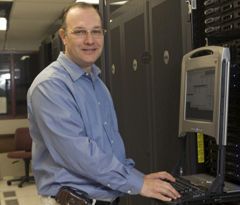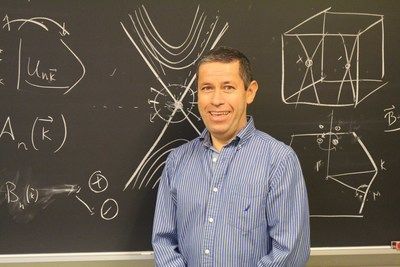
James Lewis and Aldo Romero from the Department of Physics and Astronomy, will lead a team from WVU, University of Southern California and Kitware, Inc. to develop new machine-learning tools for advancing chemical and materials science discoveries on the nation’s future high-speed computing platforms.
MORGANTOWN, W.Va. -- Researchers from
West Virginia University
have received $1.34 million to develop machine-learning software for the
U.S. Department of Energy.
The researchers, James Lewis and Aldo Romero from the Department of Physics and Astronomy, will lead a team from WVU, University of Southern California and Kitware, Inc. to develop new machine-learning tools for advancing chemical and materials science discoveries on the nation’s future high-speed computing platforms.

James Lewis
“Machine-learning was touted as mere science fiction before. Now, we are making
it reality here at WVU,” said Lewis, the principal investigator on the study.
“This funding opportunity will continue to establish WVU as one of the leaders
in machine-learning from applications in cybersecurity, biometrics and now materials
design.”
A goal of the new award from DOE’s Computational Chemistry Sciences Program is to take advantage of the nation’s petascale computers currently deployed at DOE national laboratories, such as the Summit at Oak Ridge National Laboratory, recently ranked fastest in the world. Romero and Lewis will develop machine-learning tools that will also be used on the faster, next generation exascale machines expected to be deployed beginning early in the next decade.
Petascale machines are capable of at least one quadrillion calculations per second, while exascale machines, the first scheduled for deployment at Argonne National Laboratory in 2021, will be capable of at least one quintillion calculations. The new software is expected to aid in the development of new catalysts, solvents, photo-sensitive materials and a range of other molecules and chemical processes.

Aldo Romero
“Developing methods and algorithms that can be deployed for new applications is
really challenging,” Romero said. “We will need large parallelization schemes
to improve the computer’s core communication.”
Applications will cover areas such as fossil energy production, electrical energy storage and solar cells, ultimately benefitting a wide range of technologies throughout the U.S. economy.
“Processes such as catalysis and solar energy absorption from solar cells can only be improved if our understanding on each case is done at the atomic level,” Romero said. “As the number of possible scenarios increases with the complexity of the system, we need machine-learning tools to help us identify better materials for such applications.”
In total, the DOE announced $21.6 million in funding for 10 research awards to develop advanced software for the design of new chemicals and chemical processes for energy production and a range of other potential applications. The software developed under these awards will be open source and available to the entire scientific and industrial communities.
“With their leadership in open-source software over the past decade and over $2.1 million in previous NSF-funded materials genomics awards, both Romero and Lewis are well-suited for rapid materials discovery,” said Duncan Lorimer, acting chair of the Department of Physics and Astronomy.
-WVU-
ks/12/03/18
CONTACT: Katlin Swisher, Eberly College of Arts and Sciences
304.293.9264;
Katlin.Swisher@mail.wvu.edu
Follow @WVUToday on Twitter.